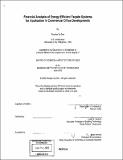Financial analysis of energy-efficient façade systems for application in commercial office developments
Author(s)
Dee, Rocelyn Sy, 1976-
DownloadFull printable version (16.58Mb)
Other Contributors
Massachusetts Institute of Technology. Dept. of Architecture.
Advisor
Leslie K. Norford.
Terms of use
Metadata
Show full item recordAbstract
Advocates for sustainable development have been campaigning for the implementation of green features in developments. New and high-technology energy-efficient technologies, such as photovoltaic cells and double skin façades, have been difficult to incorporate in developments even though they carry with them the promise of better performance and greater environmental impact. While some proponents of green development would have us believe that energy-efficient technologies are worthwhile investments, the truth is that the benefits do not always outweigh the costs. The key is promoting mass applications of these technologies is by providing an instrument for decision-makers to understand performance implications of building systems choices as represented by financial costs and benefits. It is through this holistic comprehension, as opposed to a dissection of development components, that risk perception can be mitigated and well-informed decisions can be made. This proposal presents a financial analysis of the implications of different façade. These systems will be applied to a similar base building with same performance specifications for a controlled comparison. The building type will be limited to commercial offices. It is important to note that the objective is not to arrive at an absolute cost valuation, but rather to cognize the relative efficiencies of one against the other. By using currency-based values as a representation of advantages and disadvantages, we are communicating in a common language familiar to decision-makers. This thesis hopes to achieve a better understanding of the efficiencies, or inefficiencies, of using high-technology façades. While the primary goal is to achieve a more accurate picture of the financial performances of high-technology energy efficient systems against conventional systems, the analysis will also give us a good understanding as to what barriers stand in the way, and what conditions have to exist for them to achieve widespread application. In the end, this could be the more valuable contribution.
Description
Thesis (S.M.)--Massachusetts Institute of Technology, Dept. of Architecture, 2002. Includes bibliographical references (116-120).
Date issued
2002Department
Massachusetts Institute of Technology. Department of ArchitecturePublisher
Massachusetts Institute of Technology
Keywords
Architecture.